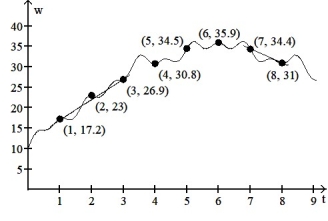Solve the problem.
-The wind speed is tracked as a storm approaches. The maximum speed w of wind gusts, in miles per hour, t hours after midnight on the night of an approaching storm is given in the figure.
a.Find the slope of the secant line that passes through points (1, 17.2) and (3, 26.9) . Interpret your answer as an average rate of change over the interval 1 t 3.
b.Repeat the procedure outlined in part (a) for the secant line that passes through points (7, 34.4) and  c. Notice that the curve in the figure is generally increasing until t = 6, and is generally decreasing after
c. Notice that the curve in the figure is generally increasing until t = 6, and is generally decreasing after 
Give a plausible explanation for this behavior.
A)
a. 4.85, the wind is increasing in speed at an average rate of 4.85 mph
b. -3.4, the wind speed is decreasing in speed at an average rate of 3.4 mph
c.The storm reached its farthest point about 6:00 a.m. and is moving closer after that.
B)
a. 9.7, the wind is increasing in speed at an average rate of 9.7 mph per hour
b. -3.4, the wind speed is decreasing in speed at an average rate of 3.4 mph per hour
c.The storm reached its closest point about 6:00 a.m. and is moving away after that.
C)
a. 4.85, the wind is increasing in speed at an average rate of 4.85 mph
b. -3.4, the wind speed is decreasing in speed at an average rate of 3.4 mph
c. The storm reached its closest point about 6:00 a.m. and is moving away after that.
D)
a. 4.85, the wind is increasing in speed at an average rate of 4.85 mph per hour
b. -3.4, the wind speed is decreasing in speed at an average rate of 3.4 mph per hour
c.The storm reached its closest point about 6:00 a.m. and is moving away after that.
Correct Answer:
Verified
Q55: Graph the function. Determine the symmetry, if
Q56: Graph the function. Determine the symmetry, if
Q57: Graph the function. Determine the symmetry, if
Q58: Solve the problem.
-The distance an object
Q59: Solve the problem.
-A marine biologist determines
Q61: Solve the problem.
-The accompanying figure shows
Q62: Solve the problem.
-The accompanying figure shows
Q63: Solve the problem.
-The accompanying figure shows
Q64: Solve the problem.
-The accompanying figure shows
Q65: Solve the problem.
-The accompanying figure shows
Unlock this Answer For Free Now!
View this answer and more for free by performing one of the following actions

Scan the QR code to install the App and get 2 free unlocks

Unlock quizzes for free by uploading documents